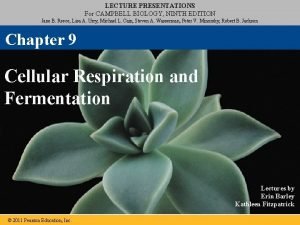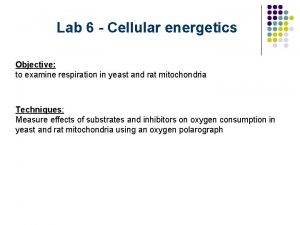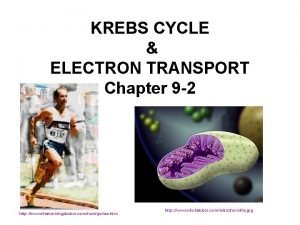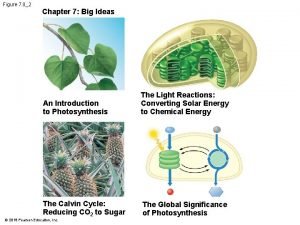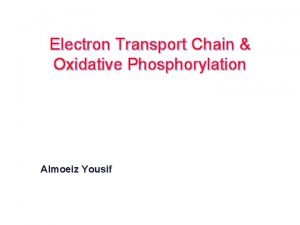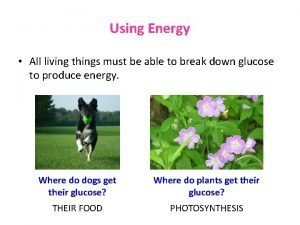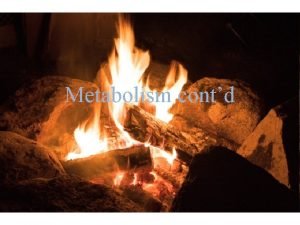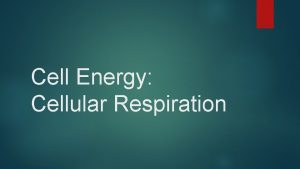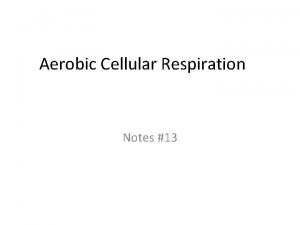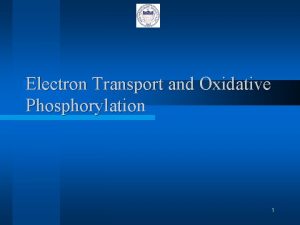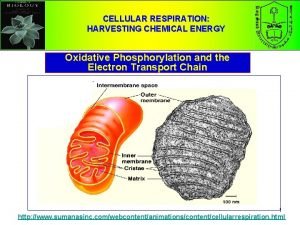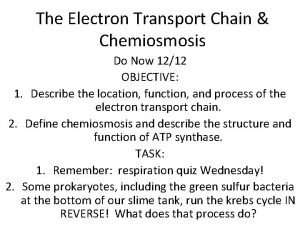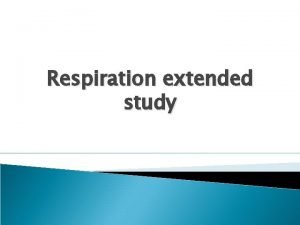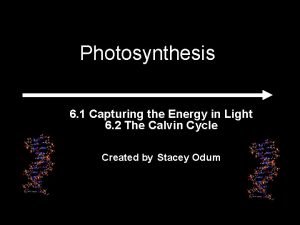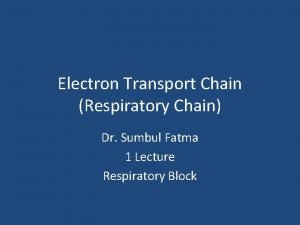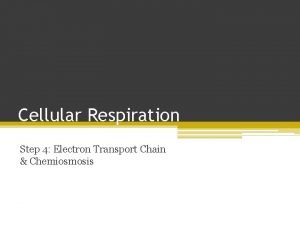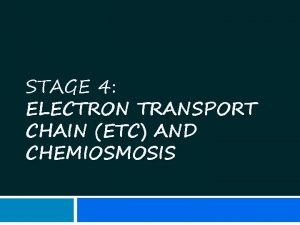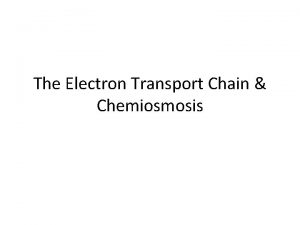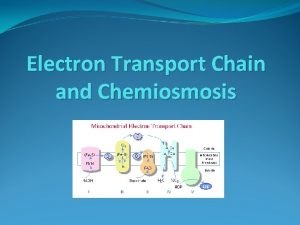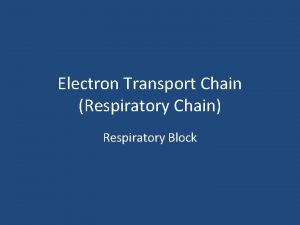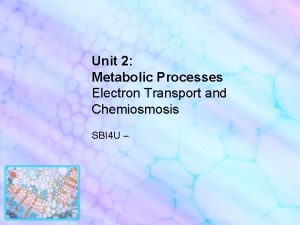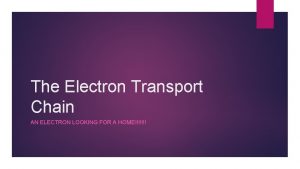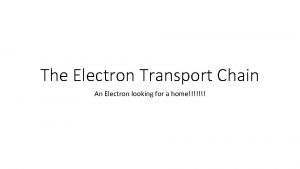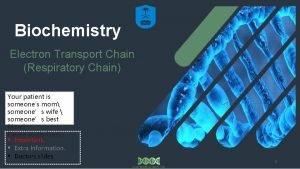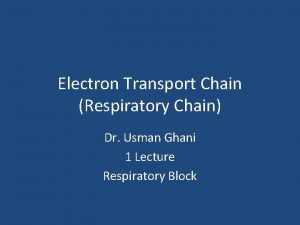The Electron Transport Chain Chemiosmosis Do Now 1212















- Slides: 15

The Electron Transport Chain & Chemiosmosis Do Now 12/12 OBJECTIVE: 1. Describe the location, function, and process of the electron transport chain. 2. Define chemiosmosis and describe the structure and function of ATP synthase. TASK: 1. Remember: respiration quiz Wednesday! 2. Some prokaryotes, including the green sulfur bacteria at the bottom of our slime tank, run the krebs cycle IN REVERSE! What does that process do?

Reductive Krebs Cycle • It builds carbohydrates by reducing CO 2! • Total detail – if this confuses you, fuggetabowdit: only a few wacky prokaryotes do it. • Odd fact: this reverse version probably evolved before the oxidative one!

Aerobic Respiration 1. Glycolysis: C 6 H 12 O 6 2 C 3 H 4 O 3 + 2 ATP + 2 NADH 2. Krebs (w/PDC): 2 C 3 H 4 O 3 6 CO 2 + 2 ATP + 8 NADH + 2 FADH 2. 3. Electron Transport chain: electrons from NADH and FADH 2 are used to create a H+ gradient across the inner membrane of the mitochondria 4. Chemiosmosis: The flow of hydrogen across the inner membrane of the mitochondria powers the ATP synthase enzyme, which produces 32 additional ATP molecules from ADP + Pi.

Aerobic Overview • 2 steps so far: – Glycolysis splits sugar into 2 pyruvates • Makes a little ATP (2) and NADH (2) – Krebs cycle (w/PDC) oxidizes Pyruvate compound to 3 CO 2 • Makes a little ATP (2) and LOTS of reduced coenzymes (6 NADH & 2 FADH 2 per glucose) • 2 steps to go – Electron Transport Chain creates H+ gradient in mitochondria – Chemiosmosis produces ATP using the energy of the gradient.

In The Mitochondria • The intermembrane space is where H+ ions are pumped by the ETC. • The matrix (where the Citric Acid Cycle occurs) has a lower H+ concentration


The Electron Transport Chain Makes a Hydrogen Gradient H+ H+ e- H+ H+ MATRIX INTERMEMBRANE SPACE H+ H+ Electrical energy allows ACTIVE transport from low concentration to hi. H+ H+

ETC • Play Clip


CHEMIOSMOSIS: Converting a H+ gradient into ATP energy Things Fall Down Stairs. Atoms Diffuse From High Concentration to Low. This molecular machine converts the released energy into ATP.

Electrons or water, the idea is the same

The Best Protein Animation Ever • ATP synthase clip

Recap: ETC • The electrons ripped from food molecules (like glucose) are carried to the electron transport chain by NADH and FADH 2. • The ETC is a series of proteins embedded in the mitochondrial inner membrane. • The flow of electrons through the ETC powers the pumping of H+ ions from the mitochondrial matrix into the intermembrane space. At the end of the ETC, the electrons are transferred to oxygen, forming water (with H+).

Recap: Chemiosmosis & ATP Synthase • The flow of protons (H+) down their concentration gradient through the enzyme ATP synthase (aka chemiosmosis) powers the synthesis of ATP from ADP + Pi (located in the matrix). • The ETC + chemiosmosis produces 32 ATP from the energy that was in NADH and FADH 2.

The Overall Aerobic Respiration Equation • C 6 H 12 O 6 + 6 O 2 6 CO 2 + 6 H 2 O • The process also produces 36 ATP from 36 ADP and 36 Pi.
 Electron transport chain campbell
Electron transport chain campbell Azide electron transport chain
Azide electron transport chain كريبس سايكل
كريبس سايكل Vertical
Vertical Slidetodoc.com
Slidetodoc.com Electron transport chain cellular respiration
Electron transport chain cellular respiration Where does the electron transport chain take place
Where does the electron transport chain take place Electron transport chain
Electron transport chain Electron transport chain cellular respiration
Electron transport chain cellular respiration Krebs cycle outputs
Krebs cycle outputs Electron transport chain
Electron transport chain Electron transport chain summary
Electron transport chain summary Electron transport chain
Electron transport chain Significance of electron transport chain
Significance of electron transport chain Electron transport chain
Electron transport chain Components of etc
Components of etc
